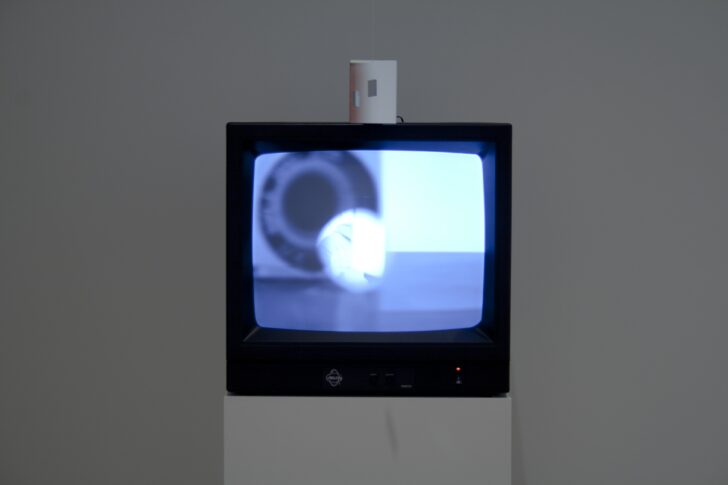Kiva
Peter Campus

Description
Gallery Addition Fall 2013
Peter Campus
United States, born 1937
Kiva
1971
Video installation
Gift of LLL, 2013/2.83
Peter Campus is a pioneer of video art who experimented with the medium in the 1970s alongside other notable artists Bill Viola, Bruce Nauman, and Joan Jonas. These innovators advanced the formal and conceptual potential
of these new image-making technologies in art frameworks. Video represented a new frontier, one that allowed artists to expand upon common artistic concerns of the era, including minimalism, performance, and conceptual art.
Kiva comprises a monitor with a closed-circuit camera mounted on top; the lens is pointed directly at the viewer of the monitor, but the camera’s view is restricted and manipulated by the placement of suspended mirrors. The camera shoots through a hole in one mirror to the surface of the other, both constantly shifting in relation to each other as they turn like a mobile. The mirrors fragment and multiply the image, allowing the camera to take in aspects of the room, the viewer, and the eye of the camera itself.
With Kiva, the viewer is put in the rare position of seeing their image in real time outside of themselves, as if they are simultaneously an observer and an actor. The title refers to a kind of ceremonial room, used by Native Americans
of the Southwest for ritual and spiritual ceremonies, imbuing the act of self-recognition and distortion with a spiritual patina, one that suggests a relationship between psychological and sacred states. The implied cognitive and emotional shifts produced by such an uncanny experience of inhabiting this dual position have been central to Campus’s work throughout his career, but perhaps never more succinctly, elegantly, and directly than in the experience of Kiva.
Subject Matter:
Translating to the "world below," Kiva refers to the round chamber used by the Pueblo for ceremonial and social gatherings. The ceremonial chamber was built underground as a representation of the connection between the world in which people lived their day-to-day lives and the ancestral world. Campus described the purpose of this work as a place that puts viewers in a "position of agency...You walk into the room and at first (“Kiva”) is unapparent. Then, there shortly comes the shock of your own image as you activate the camera...I want visitors to explore the room, even the areas out of the camera’s view, because the entire set-up—the space, the camera, even the camera mounts—are intrinsic to them.” Like many of his contemporaries, Campus' goal was to "subvert the passive viewer" and make them a participant in creating the artwork.
Physical Description:
An installation piece that consists of a television monitor on a stand with a closed-circuit camera mounted on top. The lens is pointed directly off the top of the monitor, but there are mirrors suspended from the ceiling that change the camera's perspective.
Usage Rights:
If you are interested in using an image for a publication, please visit https://umma.umich.edu/request-image/ for more information and to fill out the online Image Rights and Reproductions Request Form.